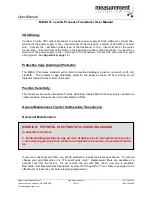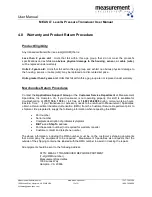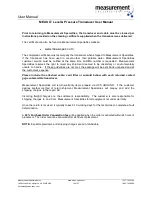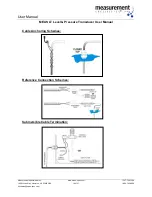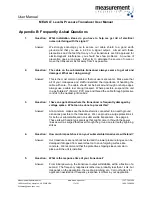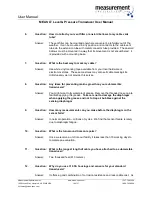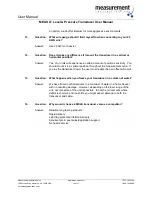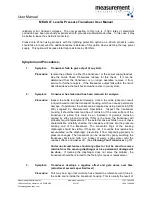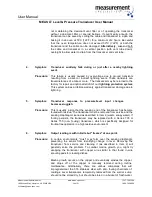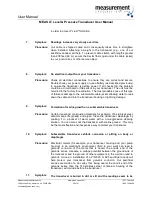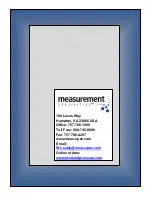
User Manual
MEAS LT Level & Pressure Transducer User Manual
Measurement Specialties, Inc.
www.meas-spec.com
1-757-766-1500
1000 Lucas Way, Hampton, VA 23666 USA
24 of 31
1-800-745-8008
not maintaining the desiccant vent filter or of operating the transducer
without a desiccant filter or aneroid bellows. If caught early enough, the
transducer can be saved by coiling the cable and transducer in a pan and
baking it in an oven at 50
º
C (122
º
F) for a minimum of 2 hours.
Be careful
that the oven temperature does not exceed 50ºC (122
º
F)
or both the
transducer and the cable can be damaged.
Alternatively
, suspend both
the cable and transducer in a vertical position (with vent tube down),
overnight to allow water to drain from the transducer and vent tube.
4.
Symptom:
Transducer suddenly fails during or just after a nearby lightning
event.
Procedure:
This failure is usually caused by overvoltage due to ground transients
resulting from a direct or indirect lightning event. These transients can
travel distances of a mile or more. The transducer may be returned to the
factory for repair and optional retrofit of our
lightning protection system.
This system carries a lifetime warranty against transducer damage due to
lightning.
5.
Symptom:
Transducer response to pressure/level input changes
becomes sluggish.
Procedure:
This is usually a sign that the sensing end of the transducer has become
fouled with residue. The transducer must be removed from service and the
sensing diaphragm cleaned as described in Item 2, (warm, soapy water). If
fouling persists, the transducer may be replaced with a Series 705 or
Series 750 (non- fouling) transducer, which is specifically designed for
trouble-free operation in a high residue environment.
6.
Symptom:
Output reading is within limits but "freezes" at one point.
Procedure:
In certain environments "crust" may form over the sensing diaphragm,
preventing the sensor from identifying change in level. Removing the
transducer from service and cleaning it (as described in Item 2) will
generally solve the problem. To combat marine growth, you might try
wrapping the transducer with copper wire similar to that found in wire
scouring pads for cleaning dishes.
Marine growth occurs on the copper and eventually erodes the copper
and drops off or the copper is manually removed during routine
maintenance. Alternatively, there are various companies that will
impregnate/coat the 316 stainless steel with anti- fouling chemicals of
coatings. Level transducers temporarily removed from the well or sump
should not be stored dry, but should be stored in a bucket of fresh water

